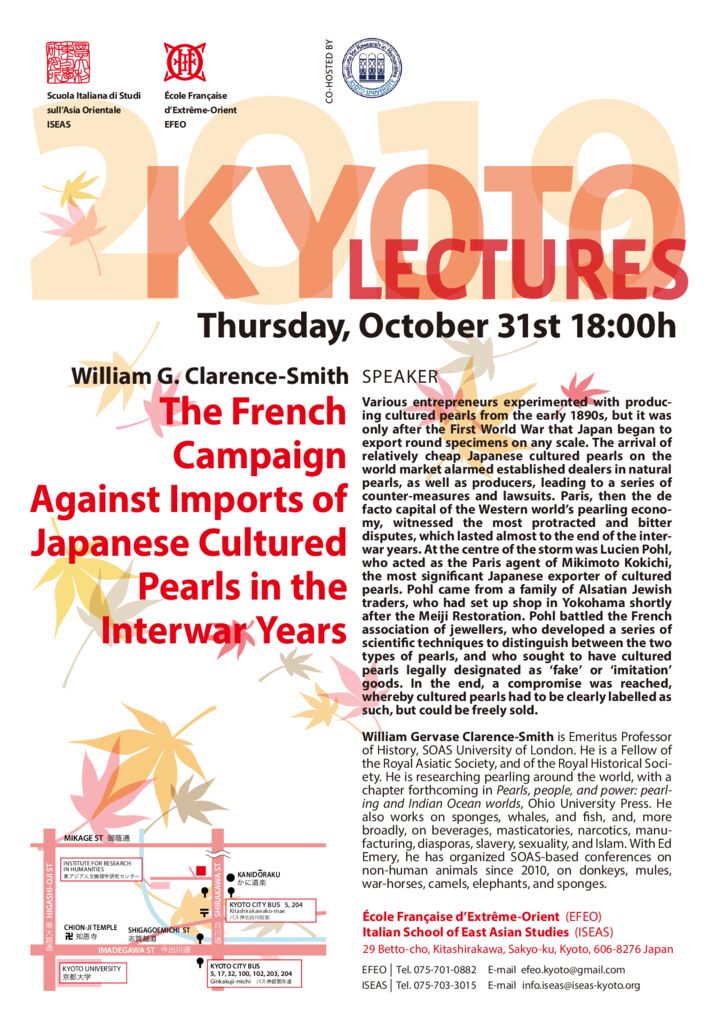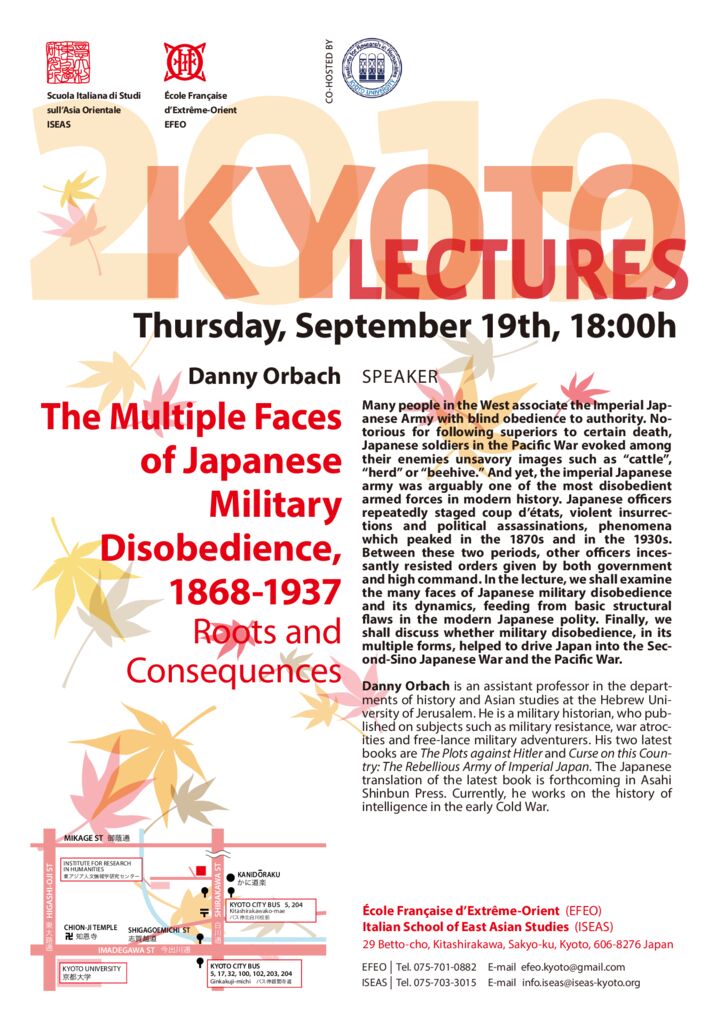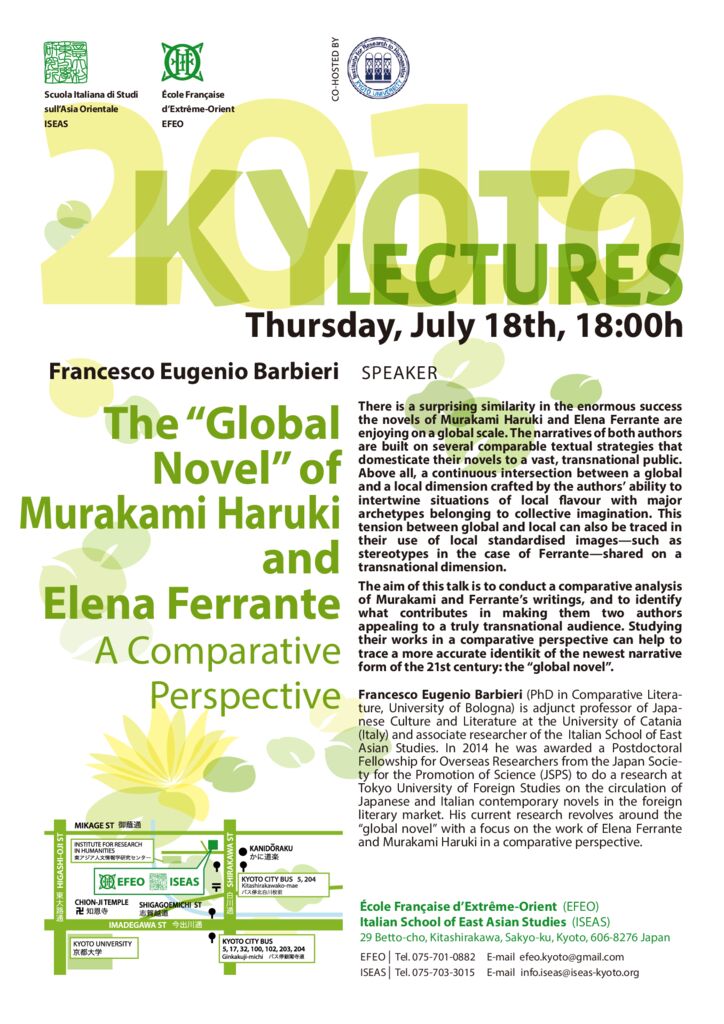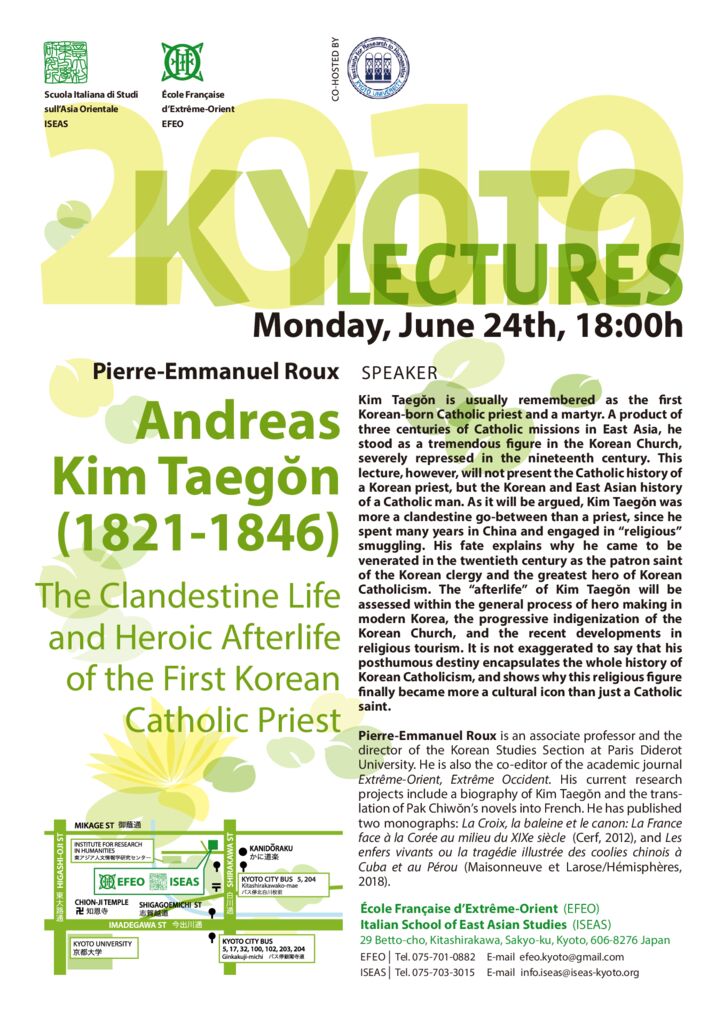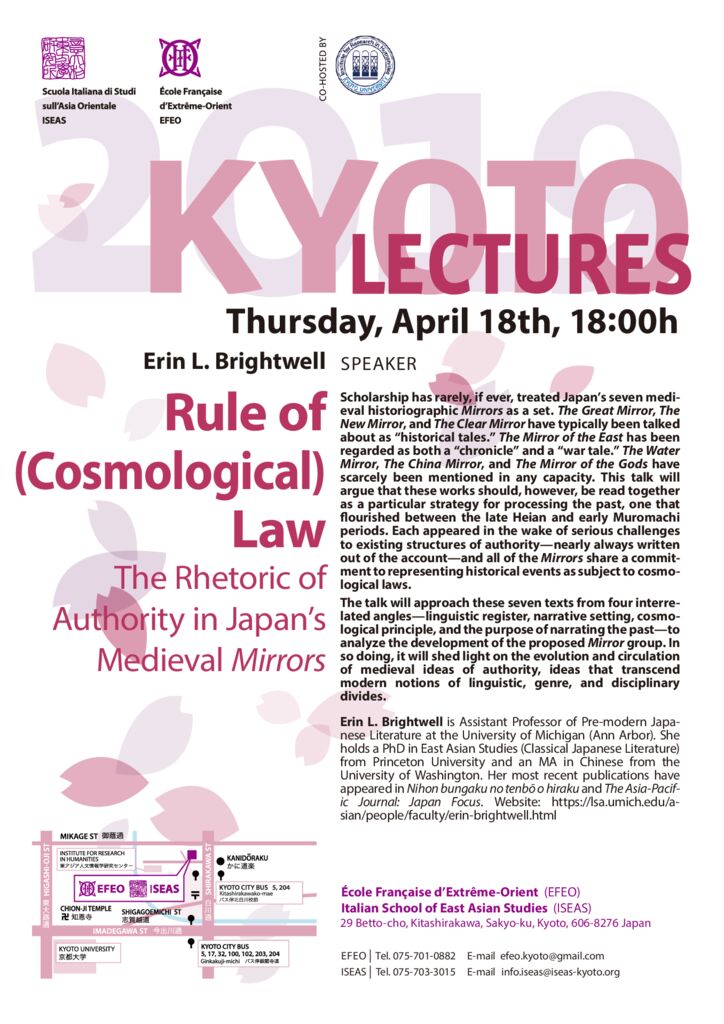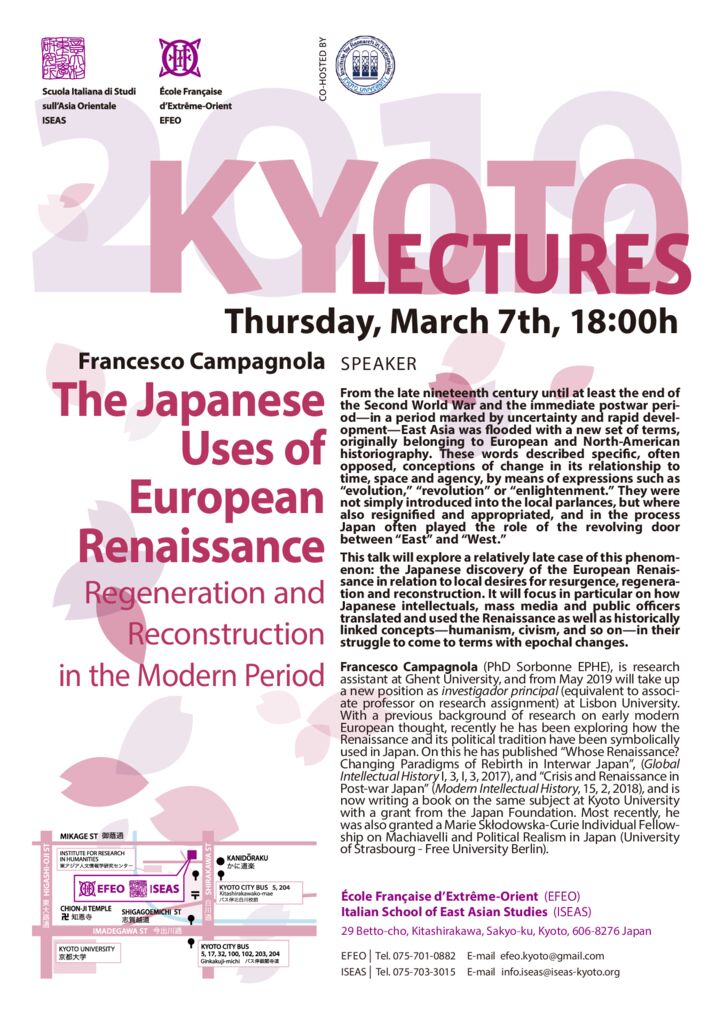Kyoto Lectures
Early Encounters of Shin Buddhism with Shintō
“Interreligious” Contacts and Hagiography
Markus Rüsch
November 28th, 2019 18:00
Italian School of East Asian Studies
Shin Buddhism is often considered to be the tradition that most radically disassociates itself from Shintō from the very beginning of its history. This is evident in one of the most well-known biographies of its founder, Shinran (1173–1263) as well as—to a significant extent—in Shinran’s own writings. However, the question of the relationship between Amida Buddha, various kami, and other Buddhist deities remained an open question.
In fact, a strategy for inclusion or exclusion of so-called “alien” religious denominations is a significant concern that Shin Buddhism shares with basically all the Buddhist sects in Japan. This talk will try to shed light on different approaches within Shin Buddhism, focussing on the writings of Kakunyo (1271–1351) and Zonkaku (1290–1373), and discussing strategies and arguments that lead to nearly opposite understandings of the relationship with Shintō. In this context, the connections between hagiography and doctrine have particular significance for the self-consciousness of a religious group. As it will be argued, hagiography is not merely a political tool to legitimize power, but also a place where an author can develop forms of doctrinal debate.
Markus Rüsch is currently JSPS International Research Fellow at Ryukoku University (Kyoto). He studied Japanese Studies and Philosophy, and holds a PhD in Japanese Studies from the Freie Universität in Berlin. He has published a few articles on the subject of hagiography, Japanese Buddhist thought, and Japanese philosophy. This year his doctoral thesis was published in Germany by Iudicium Verlag with the title Argumente des Heiligen: Rhetorische Mittel und narrative Strukturen in Hagiographien am Beispiel des japanischen Mönchs Shinran.
Kyoto Lectures
The French Campaign Against Imports of Japanese Cultured Pearls in the Interwar Years
William G. Clarence-Smith
October 31st, 2019 18:00
Italian School of East Asian Studies
Various entrepreneurs experimented with producing cultured pearls from the early 1890s, but it was only after the First World War that Japan began to export round specimens on any scale. The arrival of relatively cheap Japanese cultured pearls on the world market alarmed established dealers in natural pearls, as well as producers, leading to a series of counter-measures and lawsuits. Paris, then the de facto capital of the Western world’s pearling economy, witnessed the most protracted and bitter disputes, which lasted almost to the end of the interwar years. At the centre of the storm was Lucien Pohl, who acted as the Paris agent of Mikimoto Kokichi, the most significant Japanese exporter of cultured pearls. Pohl came from a family of Alsatian Jewish traders, who had set up shop in Yokohama shortly after the Meiji Restoration. Pohl battled the French association of jewellers, who developed a series of scientific techniques to distinguish between the two types of pearls, and who sought to have cultured pearls legally designated as ‘fake’ or ‘imitation’ goods. In the end, a compromise was reached, whereby cultured pearls had to be clearly labelled as such, but could be freely sold.
William Gervase Clarence-Smith is Emeritus Professor of History, SOAS University of London. He is a Fellow of the Royal Asiatic Society, and of the Royal Historical Society. He is researching pearling around the world, with a chapter forthcoming in Pearls, people, and power: pearling and Indian Ocean worlds, Ohio University Press. He also works on sponges, whales, and fish, and, more broadly, on beverages, masticatories, narcotics, manufacturing, diasporas, slavery, sexuality, and Islam. With Ed Emery, he has organized SOAS-based conferences on non-human animals since 2010, on donkeys, mules, war-horses, camels, elephants, and sponges.
Kyoto Lectures
The Multiple Faces of Japanese Military Disobedience, 1868-1937
Roots and Consequences
Danny Orbach
September 19th, 2019 18:00
Italian School of East Asian Studies
Many people in the West associate the Imperial Japanese Army with blind obedience to authority. Notorious for following superiors to certain death, Japanese soldiers in the Pacic War evoked among their enemies unsavory images such as “cattle”, “herd” or “beehive.” And yet, the imperial Japanese army was arguably one of the most disobedient armed forces in modern history. Japanese ocers repeatedly staged coup d’états, violent insurrections and political assassinations, phenomena which peaked in the 1870s and in the 1930s.
Between these two periods, other ocers incessantly resisted orders given by both government and high command. In the lecture, we shall examine the many faces of Japanese military disobedience and its dynamics, feeding from basic structural aws in the modern Japanese polity. Finally, we shall discuss whether military disobedience, in its multiple forms, helped to drive Japan into the Second-Sino Japanese War and the Pacic War.
Danny Orbach is an assistant professor in the departments of history and Asian studies at the Hebrew University of Jerusalem. He is a military historian, who published on subjects such as military resistance, war atrocities and free-lance military adventurers. His two latest books are The Plots against Hitler and Curse on this Country: The Rebellious Army of Imperial Japan. The Japanese translation of the latest book is forthcoming in Asahi Shinbun Press. Currently, he works on the history of intelligence in the early Cold War.
Kyoto Lectures
The “Global Novel” of Murakami Haruki and Elena Ferrante
A Comparative Perspective
Francesco Eugenio Barbieri
July 18th, 2019 18:00
Italian School of East Asian Studies
There is a surprising similarity in the enormous success the novels of Murakami Haruki and Elena Ferrante are enjoying on a global scale. The narratives of both authors are built on several comparable textual strategies that domesticate their novels to a vast, transnational public. Above all, a continuous intersection between a global and a local dimension crafted by the authors’ ability to intertwine situations of local avour with major archetypes belonging to collective imagination. This tension between global and local can also be traced in their use of local standardised images—such as stereotypes in the case of Ferrante—shared on a transnational dimension.
The aim of this talk is to conduct a comparative analysis of Murakami and Ferrante’s writings, and to identify what contributes in making them two authors appealing to a truly transnational audience. Studying their works in a comparative perspective can help to trace a more accurate identikit of the newest narrative form of the 21st century: the “global novel”.
Francesco Eugenio Barbieri (PhD in Comparative Literature, University of Bologna) is adjunct professor of Japanese Culture and Literature at the University of Catania (Italy) and associate researcher of the Italian School of East Asian Studies. In 2014 he was awarded a Postdoctoral Fellowship for Overseas Researchers from the Japan Society for the Promotion of Science (JSPS) to do a research at Tokyo University of Foreign Studies on the circulation of Japanese and Italian contemporary novels in the foreign literary market. His current research revolves around the “global novel” with a focus on the work of Elena Ferrante and Murakami Haruki in a comparative perspective.
Kyoto Lectures
Andreas Kim Taegǒn (1821-1846)
The Clandestine Life and Heroic Afterlife of the First Korean Catholic Priest
Pierre-Emmanuel Roux
June 24th, 2019 18:00
Italian School of East Asian Studies
Kim Taegǒn is usually remembered as the first Korean-born Catholic priest and a martyr. A product of three centuries of Catholic missions in East Asia, he stood as a tremendous figure in the Korean Church, severely repressed in the nineteenth century. This lecture, however, will not present the Catholic history of a Korean priest, but the Korean and East Asian history of a Catholic man. As it will be argued, Kim Taegǒn was more a clandestine go-between than a priest, since he spent many years in China and engaged in “religious” smuggling. His fate explains why he came to be venerated in the twentieth century as the patron saint of the Korean clergy and the greatest hero of Korean Catholicism. The “afterlife” of Kim Taegǒn will be assessed within the general process of hero making in modern Korea, the progressive indigenization of the Korean Church, and the recent developments in religious tourism. It is not exaggerated to say that his posthumous destiny encapsulates the whole history of Korean Catholicism, and shows why this religious figure finally became more a cultural icon than just a Catholic saint.
Pierre-Emmanuel Roux is an associate professor and the director of the Korean Studies Section at Paris Diderot University. He is also the co-editor of the academic journal Extrême-Orient, Extrême Occident. His current research projects include a biography of Kim Taegǒn and the translation of Pak Chiwǒn’s novels into French. He has published two monographs: La Croix, la baleine et le canon: La France face à la Corée au milieu du XIXe siècle (Cerf, 2012), and Les enfers vivants ou la tragédie illustrée des coolies chinois à Cuba et au Pérou (Maisonneuve et Larose/Hémisphères, 2018).
Kyoto Lectures
Observing Japanese mythologies
Why the Nihon Shoki has two books with myths but the Kojiki only one?
Robert F. Wittkamp
May 27th, 2019 18:00
Italian School of East Asian Studies
Initially, the so-called “Japanese myths” were a textual product of the Kojiki (712) and the Nihon Shoki (720). In the course of the centuries, these myths were altered, re-written, supplemented, and later were eventually exploited to serve Japanese nationalism. As a consequence, even today by using the word “Japanese myths” many people think of the Kojiki as containing an official mythology and of Amaterasu Omikami as the ancestor spirit of the imperial family. The creation of this image as a monotonously uniform mythology is the result of various developments and ideologies, but comparative mythology bears part of the responsibility as well.
However, since the late 1960s Japanese scholars have conducted a close reading of the mythical narratives contained in the first book of the Kojiki and in the two initial books of the Nihon Shoki, respectively. This has revealed distinct differences between the two corpora, breaking up the image of a homogeneous mythology. These text-oriented approaches can give a viable answer to the thorny question of why there are two books of myths in the Nihon Shoki whereas the Kojiki only has one. The talk will elucidate some of the reasons for the plurality and variability of Japanese myths as well as the reasons why it took so long to give a convincing answer to that question.
Robert F. Wittkamp teaches at Kansai University, in Osaka. His research interests are focused on Japanese literature before the end of the 8th century, and his books on Man’yoshu (2014) approach the poetry of memory to reveal the connections and relationships between landscape, writing, and cultural memory. The recently published Arbeit am Text—Zur postmodernen Erforschung der Kojiki-Mythen (2018) examines the Japanese text-oriented research on myths in the Kojiki and the Nihon shoki, and is another contribution to the investigation of Japanese early intellectual history.
Kyoto Lectures
Rule of (Cosmological) Law
The Rhetoric of Authority in Japan’s Medieval Mirrors
Erin L. Brightwell
April 18th, 2019 18:00
Italian School of East Asian Studies
Scholarship has rarely, if ever, treated Japan’s seven medieval historiographic Mirrors as a set. The Great Mirror, The New Mirror, and The Clear Mirror have typically been talked about as “historical tales.” The Mirror of the East has been regarded as both a “chronicle” and a “war tale.” The Water Mirror, The China Mirror, and The Mirror of the Gods have scarcely been mentioned in any capacity. This talk will argue that these works should, however, be read together as a particular strategy for processing the past, one that ourished between the late Heian and early Muromachi periods. Each appeared in the wake of serious challenges to existing structures of authority—nearly always written out of the account—and all of the Mirrors share a commitment to representing historical events as subject to cosmological laws.
The talk will approach these seven texts from four interrelated angles—linguistic register, narrative setting, cosmological principle, and the purpose of narrating the past—to analyze the development of the proposed Mirror group. In so doing, it will shed light on the evolution and circulation of medieval ideas of authority, ideas that transcend modern notions of linguistic, genre, and disciplinary divides.
Erin L. Brightwell is Assistant Professor of Pre-modern Japanese Literature at the University of Michigan (Ann Arbor). She holds a PhD in East Asian Studies (Classical Japanese Literature) from Princeton University and an MA in Chinese from the University of Washington. Her most recent publications have appeared in Nihon bungaku no tenbo o hiraku and The Asia-Pacific Journal: Japan Focus. Website: https://lsa.umich.edu/asian/people/faculty/erin-brightwell.html
Kyoto Lectures
The Japanese Uses of European Renaissance
Regeneration and Reconstruction in the Modern Period
Francesco Campagnola
March 7th, 2019 18:00
Italian School of East Asian Studies
From the late nineteenth century until at least the end of the Second World War and the immediate postwar period—in a period marked by uncertainty and rapid development—East Asia was flooded with a new set of terms, originally belonging to European and North-American historiography. These words described specific, often opposed, conceptions of change in its relationship to time, space and agency, by means of expressions such as “evolution,” “revolution” or “enlightenment.” They were not simply introduced into the local parlances, but were also resignified and appropriated, and in the process Japan often played the role of the revolving door between “East” and “West.”
This talk will explore a relatively late case of this phenomenon: the Japanese discovery of the European Renaissance in relation to local desires for resurgence, regeneration and reconstruction. It will focus in particular on how Japanese intellectuals, mass media and public officers translated and used the Renaissance as well as historically linked concepts—humanism, civism, and so on—in their struggle to come to terms with epochal changes.
Francesco Campagnola (PhD Sorbonne EPHE), is research assistant at Ghent University, and from May 2019 will take up a new position as investigador principal (equivalent to associate professor on research assignment) at Lisbon University. With a previous background of research on early modern Europeanthought, recently he has been exploring how the Renaissance and its political tradition have been symbolically used in Japan. On this he has published “Whose Renaissance? Changing Paradigms of Rebirth in Interwar Japan” (Global Intellectual History, 1, 3, 2017) and “Crisis and Renaissance in Post-war Japan” (Modern Intellectual History, 15, 2, 2018), and is now writing a book on the same subject at Kyoto University with a grant from the Japan Foundation. Mostrecently, he was also granted a Marie Skłodowska-Curie Individual Fellowship on Machiavelli and Political Realism in Japan (University of Strasbourg – Free University Berlin).
Kyoto Lectures
Counter-Reformation Heroes in the Making
The Beatification of the 26 Martyrs of Nagasaki
Hitomi Omata Rappo
February 14th, 2019 18:00
Italian School of East Asian Studies
The Twenty-six Martyrs of Nagasaki—a group of missionaries and local converts executed in 1597—were beatified by the Catholic Church thirty years later, with unusual speed if compared to other contemporary examples. Their beatification was in fact an extremely peculiar case, as they were the first beati from the territories newly connected to Europe. On the other hand, the process showed the rivalries between the missionary orders: it was initiated by the Franciscans and the Dominicans, and the Jesuits were at first reluctant to fully admit the validity of the martyrdom.
The talk will analyze this process by making use of documents in the Vatican archives. In particular, it will show how it was carried out involving official courts established in Nagasaki, Macao, and even New Spain (modern-day Mexico), with repeated interrogations of witnesses—in some cases more than twenty years after the facts—in search of concrete justifications of the martyrs’ sanctity, and of their miracles in particular. The consequences of such exceptional event especially for the Society of Jesus will also be examined through the cult and iconography of the martyrs, and its impact on later cases of martyrdom in the Japanese mission.
Hitomi Omata Rappo received a Ph.D. in Religious Studies from the École Pratique des Hautes Études (Sorbonne) and in History from the University of Fribourg. In her dissertation she analyzed how the images and stories of Japanese “martyrs”, first recorded in missionaries’ reports, were reproduced in the hagiographic literature, and circulated in Catholic Europe as a popular theme of the Jesuit school drama. Her book on the same subject will be published by Aschendorff (Münster) in 2019.
Kyoto Lectures
In a State of Excess
"Reckless Gathering" and the Meiji Cultivation of Ago Bay
Kjell Ericson
January 15th, 2019 18:00
École Francaise d’Extrême-Orient
Across the nineteenth century world, conservation policy emerged alongside discourses of plants and animals in crisis. Hunters, gatherers, and catchers became subject to criticism for “destruction” and “exhaustion” on land and in the water. Such was the case along the coasts of Meiji Japan. Looking to Euro-American examples and to environmental interpretations of Japan’s political transformation, the Meiji state fisheries bureaucracy began to see local practices in terms of excess, most commonly “reckless gathering” or rankaku.
This talk revisits the contentious beginnings of pearl cultivation in Mie Prefecture’s Ago Bay, the world’s center of pearl farming for most of the twentieth century. Pearl cultivation did not simply come to Ago Bay. To the contrary, pearl cultivation and Ago Bay itself were co-constructions of Meiji conservation’s central problem of “reckless gathering,” which became tied not just to the regulation of gatherers but also to a search for alternative ways of governing animals. In southern Mie, this included individual, monopoly control over salt water and pearl-bearing shellfish under a rubric of “cultivation” or yōshoku.
Kjell Ericson (PhD, Princeton University) is Program-Specific Assistant Professor at Kyoto University, with affiliations in the Graduate School of Letters and Joint Degree Master’s Program in Transcultural Studies. His research focuses on environmental history in the Japanese archipelago, often underpinned by trans-regional histories of science and technology. Currently he is working on a book-length manuscript entitled Pearl Capital: Ago Bay and the Cultivation of Coastal Japan, 1880-1970. He has published essays in the Journal of the History of Biology and forthcoming edited volumes on the history of marine biology (University of Chicago Press) and intellectual property (Cambridge University Press).

